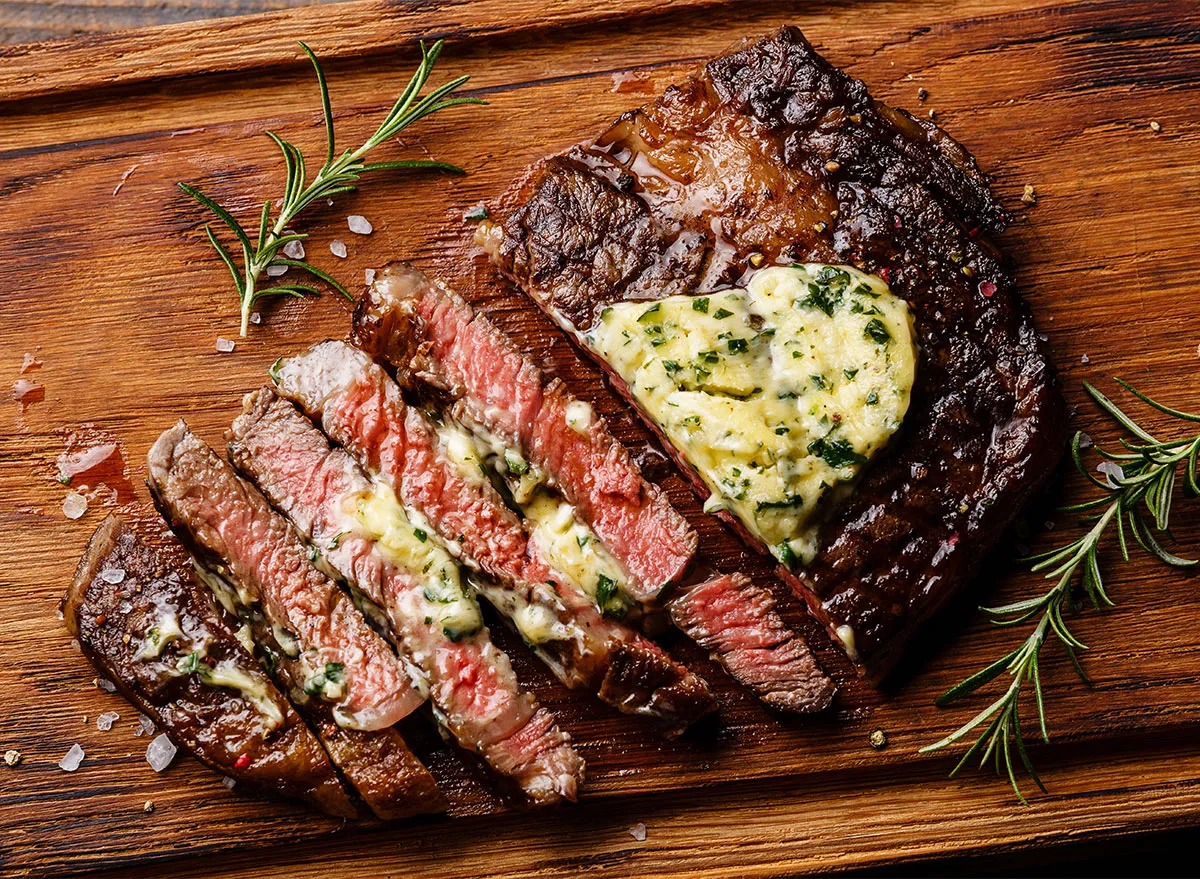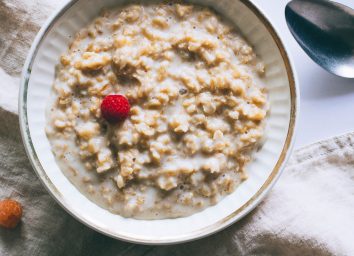
Beef, pork, lamb, venison, and even goat meat all fall under the "red" umbrella of meats, which are pink or red when raw (and darker when cooked). These animal products are high in key nutrients like protein, iron, and vitamin B12—and if you're a meat eater, you probably find them pretty tasty, too. Savory, juicy, and full of flavor, red meat is an all-around favorite among Americans. Statistics show that in 2021 alone Americans ate approximately 111.5 pounds of red meat per capita. Given this large amount, you might wonder what happens to your body if you're eating this many servings (or more) on a regular basis.
However, there are reasons why plant-based eating appears to be on the rise, experts have historically asked that the Dietary Guidelines for Americans to make more concrete recommendations around red meat consumption, and public health organizations like the World Cancer Research Fund recommends limiting red meat to no more than three servings per week. Despite red meat's many nutrients, as it turns out, the news isn't entirely sunny—especially when not consumed in healthy moderation.
While the news about red meat isn't all glum, awareness of the the possible benefits and side effects of eating red meat on a daily basis can help you make a well-informed decision about whatever you choose to put in your body. With that in mind, here are some of the potential effects of eating red meat every day. And for more healthy eating tips, be sure to check out What Happens to Your Body When You Eat Salad Every Day.
You'll reap the health benefits of protein

Meats like beef and venison are some of the highest-protein foods around. A 3-ounce serving of deer meat, for example, has 26 grams of protein, and 4 ounces of ground beef supplies 23 grams. Since the Daily Value for protein is 50 grams, including these meats every day can certainly get you close to your goals.
Your cholesterol may go up

Cholesterol—both LDL (the "bad" kind) and HDL (the "good" kind)—is an important indicator of cardiovascular health. As this waxy substance builds in your blood vessels, it can narrow the space for oxygen-rich blood to travel, ultimately even causing blockages that cause heart attacks or strokes.
Unfortunately, eating burgers or chops every day won't do your cholesterol any favors. Red meat, in particular, is notorious for raising LDL. Research from Oxford University even found that people's coronary heart disease risk increased by 18% for every 50 grams of extra processed red meat they ate per day, and rose by 9% for every 50 grams of unprocessed meat.
You may increase your risk of type 2 diabetes

It may seem like type 2 diabetes only has to do with your carb intake, since this condition involves the body's regulation of blood sugar. But proteins like red meat could also influence whether or not you develop type 2. In 2014, a study in Nutrients concluded that meat consumption was consistently associated with type 2 diabetes risk. Researchers speculated that this could be because red meat can increase inflammation, raise body weight, or increase visceral fat—all known factors in the development of diabetes.
Then again, research from 2022 that assessed 21 randomized controlled trials found that red meat did not affect type 2 diabetes risk factors like insulin resistance and pancreatic beta cell function. But until further research brings more clarity, it may be best to scale back on steaks if you know you're at risk of diabetes. To make blood sugar-friendly choices, start with our list of 50 best foods for people with diabetes.
You could feel more energized

Protein isn't the only nutrient superstar in beef, pork, lamb, and venison. Vitamin B12 and iron are also abundant in red meat. You might not give too much thought to these micronutrients beyond noticing them in your multivitamin, but they have a significant role to play in your health. Both are important components in keeping your energy up. A deficiency of either can lead to fatigue and weakness. Translation: eating red meat every day could be insurance against feelings of sluggishness.
You may increase your risk of colorectal cancer

Another downside of a daily red meat habit: you may be upping your odds of contracting colorectal cancer. Research has accumulated over the last few decades, including a 2015 study by the Department of Medical Oncology, Institute of Oncology at Istanbul University published in Oncology Reviews, which suggests a link between the higher consumption of meats like beef, pork, and lamb and a greater likelihood of this bowel disease.
It's worth noting, though, that all red meats don't appear to have the same effects. While red meat does seem to increase risk, processed red meats have an even greater impact on colon cancer development. According to WHO's International Agency for Research on Cancer, red meat is classified as a group 2A carcinogen, meaning they're "probably carcinogenic to humans." Processed red meats, on the other hand, are classified as a group 1 carcinogen—a substance known to cause cancer.
You'll feel full

Protein is nothing if not satiating. In fact, research shows this macronutrient is the most filling one of all! By including red meat in your diet every day, you may feel fuller longer, which could lead to a steady weight. Combining red meat with other satiating nutrients like complex carbohydrates and healthy fats (such as pairing lamb with quinoa or cooking pork in olive oil) could compound weight maintenance even further.
- Source: https://www.statista.com/statistics/183627/per-capita-consumption-of-red-meat-in-the-us-since-2000/#:~:text=The%20consumption%20of%20red%20meat,pounds%20per%20capita%20in%202021.
- Source: https://www.ox.ac.uk/news/2021-07-21-red-and-processed-meat-linked-increased-risk-heart-disease-oxford-study-shows
- Source: https://www.ncbi.nlm.nih.gov/pmc/articles/PMC3942738/
- Source: https://www.nature.com/articles/s41430-022-01150-1
- Source: https://www.ncbi.nlm.nih.gov/pmc/articles/PMC6611390/
- Source: https://www.ncbi.nlm.nih.gov/pmc/articles/PMC4698595/
- Source: https://academic.oup.com/ajcn/article/87/5/1558S/4650426









